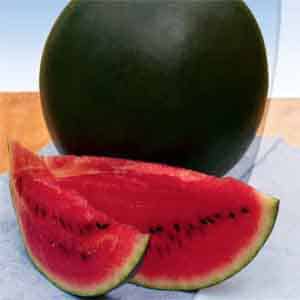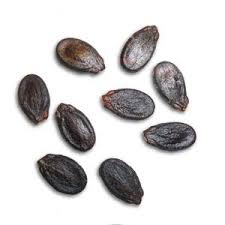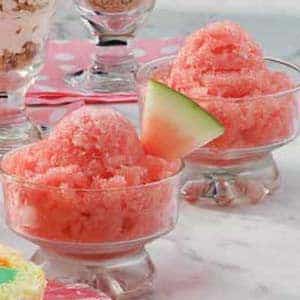An early ripening sweet variety of watermelon “Ogonyok”, resistant to diseases and unpretentious in care
Watermelon Ogonek is grown in different climatic zones: in the north, south and in the middle zone. The variety is easy to care for and cold-resistant, and shows stable yields. Ogonek is suitable for fresh consumption and for preparing fruit snacks. The pulp of watermelon is sweet and aromatic.
Let's take a closer look at the characteristics of the variety and learn the secrets of a rich harvest.
Description of the watermelon variety
Early ripening variety: ripens in 70–80 days from the moment the first shoots appear. It is recommended to plant seedlings.
Distinctive features

Ogonek is distinguished by medium-sized bushes. There are many leaves, the color is dark green, uniform.
When growing the plant needs shaping. Resistance to diseases and pests is excellent.
Composition, properties, calorie content
Watermelon pulp is rich in antioxidants that remove toxins and waste from the body.. B vitamins and carotene have a positive effect on vision, vitamin C strengthens the immune system.
Folic acid prevents headaches, folacin regulates metabolism. Consuming watermelon in moderation improves digestion and gives a healthy complexion to the skin. 100 g of watermelon contains 30 kcal.
Important! Watermelon helps to get rid of excess weight. The fruit has a diuretic effect, removes excess fluid from the body and saturates well.
Fruit characteristics and yield
The shape of the fruit is spherical, slightly flattened. The peel is medium thick, matte dark green.The flesh is rich red, grainy and sweet. The weight of one fruit is from 1.5 to 2.5 kg. Productivity reaches 6 kg from 1 bush.
Seeds of watermelon

Seeds small black-brown.
They have valuable properties: medicinal tea is prepared from them to normalize kidney function. Add 30 crushed seeds to 2 liters of water.
How to grow a variety
Watermelon seedlings are prepared in mid-March. Let's consider what its preparation involves and how to care for the plant on the site.
Preparing seedlings
Watermelon seeds Ogonyok are purchased in specialized stores for gardeners. Pay attention to the packaging: it must be intact, with a valid expiration date.
Seeds are disinfected in one of the following ways:
- placed in the freezer for a day;
- soak in aloe juice for 5 hours;
- treated with a solution of Bordeaux mixture.
After disinfection, the seed material is germinated. It is wrapped in warm, damp gauze and placed on the windowsill. This improves seed germination and protects against possible diseases.
Sow watermelon in seedling containers: cups, flower pots, cardboard boxes. The container is filled with earth and holes are made. Place 1-2 seeds in each.
Important! For seedlings, use ready-made soil from the store. It is disinfected and does not contain larvae or weeds. It is recommended to add river sand or sawdust to the purchased soil. They will make the soil lighter and looser.
Ogonyok seedlings are placed in a warm and sunny place. The length of daylight for the healthy development of seedlings is at least 12 hours. If there is a deficiency, additional phytolamps are installed. Water the sprouts as the soil dries, fertilize once every 15 days. They are fed with liquid organic matter: mullein, herbal solution, chicken droppings.
Vegetable garden planting and care
The crop is planted in open ground after spring frosts. The Ogonyok planting pattern is 60x100, row spacing is about 1.5 m. The beds must be heated and breathable.
The planting depth is 10 cm, the sprouts are placed in the grooves and the base of the stem is sprinkled with earth. For 10 days, the bushes are covered with film to protect them from winds and rain. After this film is removed.
Important! When growing, it is important to keep the beds clean: loosen the soil, remove weeds and debris. Weeds obscure the sun, causing watermelons to lack light and heat.
Water Ogonyok once every 4-5 days. About 1.5 liters of water are consumed per bush. During the period of fruit formation, the amount of moisture is reduced, since its excess leads to growth inhibition. To increase productivity, the plant is fed with mineral and organic fertilizers: potassium chloride, manure, ammonium nitrate, ash, and nettle infusion.
Features of cultivation and possible difficulties
To grow a rich harvest in the northern regions, the Ogonyok variety is grown in a greenhouse. In cloudy and cool weather, melons are poorly pollinated, but such rooms are always warm.
The design protects watermelons from high humidity, fog and dew. Before planting, the walls and doors of the greenhouse are wiped with a solution of potassium permanganate, the ground is dug up, and cleaned of debris and weeds.
A month after planting, the plant is formed: long side shoots are removed, 2-3 central shoots are left. The top is pinched, the lashes are untangled and sprinkled with earth in several places. Formation increases productivity and protects against rot. If this is not done, many small unleavened fruits will form.
Diseases and pests
Wireworms are found in watermelon beds.It gnaws through plant roots, which disrupts metabolism. For preventive purposes, gardeners weed the beds, remove weeds and loosen the soil. They get rid of wireworms using the drug “Decis”.
Another pest aphid. The miniature white midge lives on the leaves of plants and sucks out the nutritious juices from them. Get rid of insects by spraying with whey.
Typical diseases include bacteriosis. The leaves become covered with oily light spots, the bushes wither. Watermelons lose their elasticity, the taste becomes fresh and watery. Bacteriosis appears due to high humidity or improper care. For prevention purposes, the crop is sprayed with copper sulfate. For treatment, purchase “Quadris” or “Maxim”.
Important! With sudden temperature changes, watermelon is affected by root rot. The bushes dry out and the fruits spoil. Disease prevention is to dust the beds with wood ash once a week.
Harvesting and application

Early ripening Ogonyok is harvested at the end of August. Fruit ripeness identified by uniform color and dense peel. The watermelon becomes hard and the stem becomes dry.
After harvesting, the fruits are wiped with clean napkins. Part of the harvest is used immediately, part is put into the basement for long-term storage (maximum period - 1 month).
The pulp is used to make juice, jam, compotes And jams. Watermelon is combined with lemon, melon, banana, mint and lime juice. It’s impossible to imagine a picnic or barbecue without it. The compact fruits of Ogonyok are convenient to take with you.
Apply sugary pulp and for preparing salads and side dishes. For example, they prepare an appetizer from slices of watermelon and feta cheese. The dish is seasoned with olive oil and served.
Interesting! These fruits make delicious sorbet. It contains no sugar and is refreshing in hot weather. Make a puree from the pulp of watermelon and lemon and freeze it in the freezer. For piquancy, add a few drops of rum.
Advantages and disadvantages of the variety
The advantages include the following:
- juicy and aromatic pulp;
- ease of care;
- cold resistance;
- immunity to diseases and pests;
- versatility in use.
Among the disadvantages, gardeners note short shelf life. Due to the thin peel, Ogonyok is not transported over long distances: it is recommended to consume the crop as soon as possible.
Reviews
What do Russian gardeners say about the Ogonyok variety? Let's look at a few reviews from online forums:
Alexey, Moscow: “Watermelon Ogonyok is my favorite. The yield is always high; I collect 8–10 fruits from the garden. The taste is excellent, very sweet. We eat the fruits with the whole family and distribute them to friends.”
Maria, Orel: “I grow the variety in seedlings in a greenhouse. I water only with warm water, fertilize with liquid organic matter and superphosphate. The variety did not suffer from any diseases, there were no pests.”
Nikita, Chelyabinsk: “The light disappointed me. In the cool Ural summer, the fruits set slowly and the harvest was average. I rated the taste 3 out of 5.”
Conclusion
Velvety watermelon Ogonyok is a favorite of gardeners. The variety is grown by seedling method. In the north they use greenhouses, in the south the crop is placed in open ground. Care involves timely watering and fertilizing.
To protect against diseases and pests, the beds are loosened and cleared of weeds. Harvest in August. The aromatic fruits are eaten fresh and made into fruity, refreshing snacks.